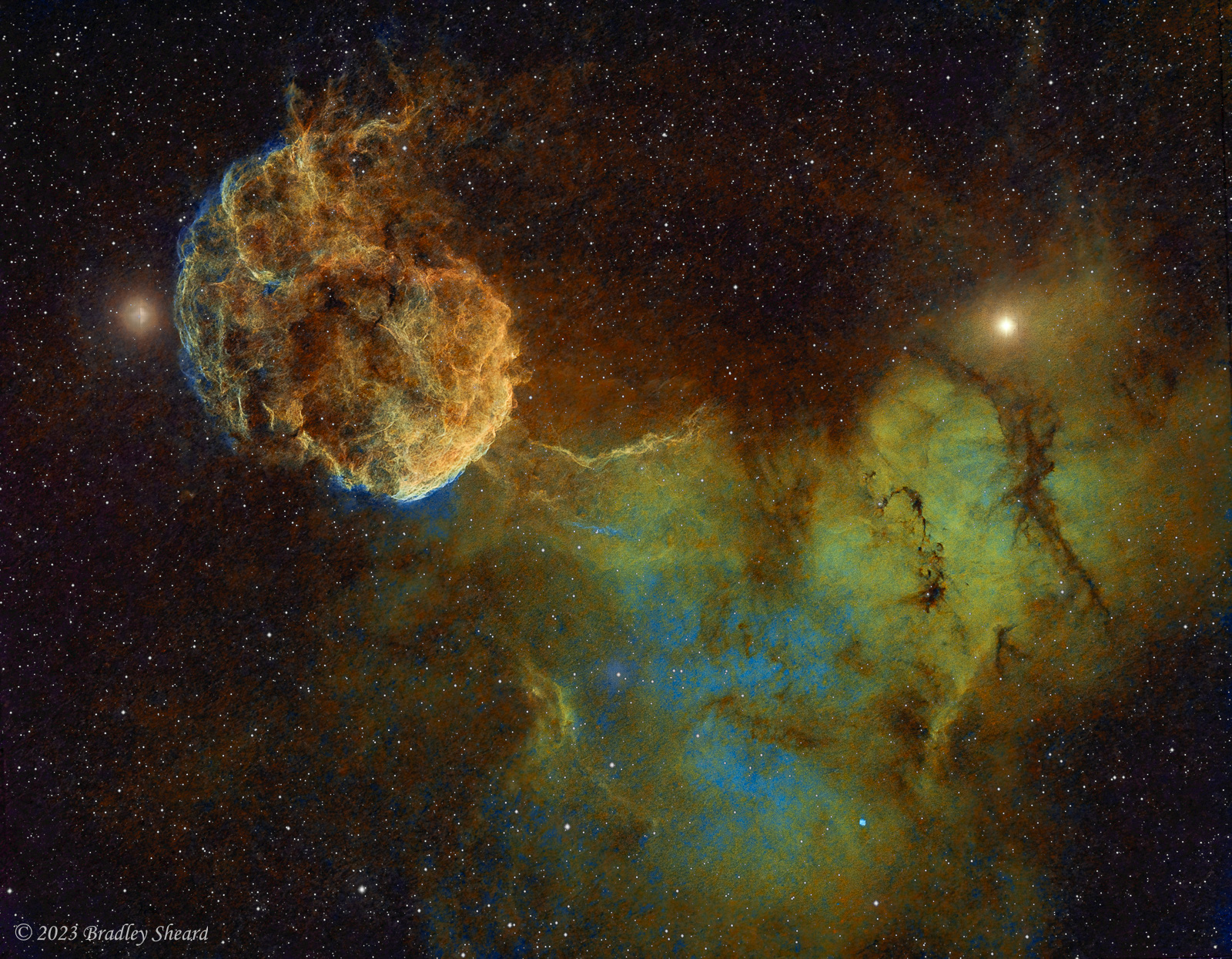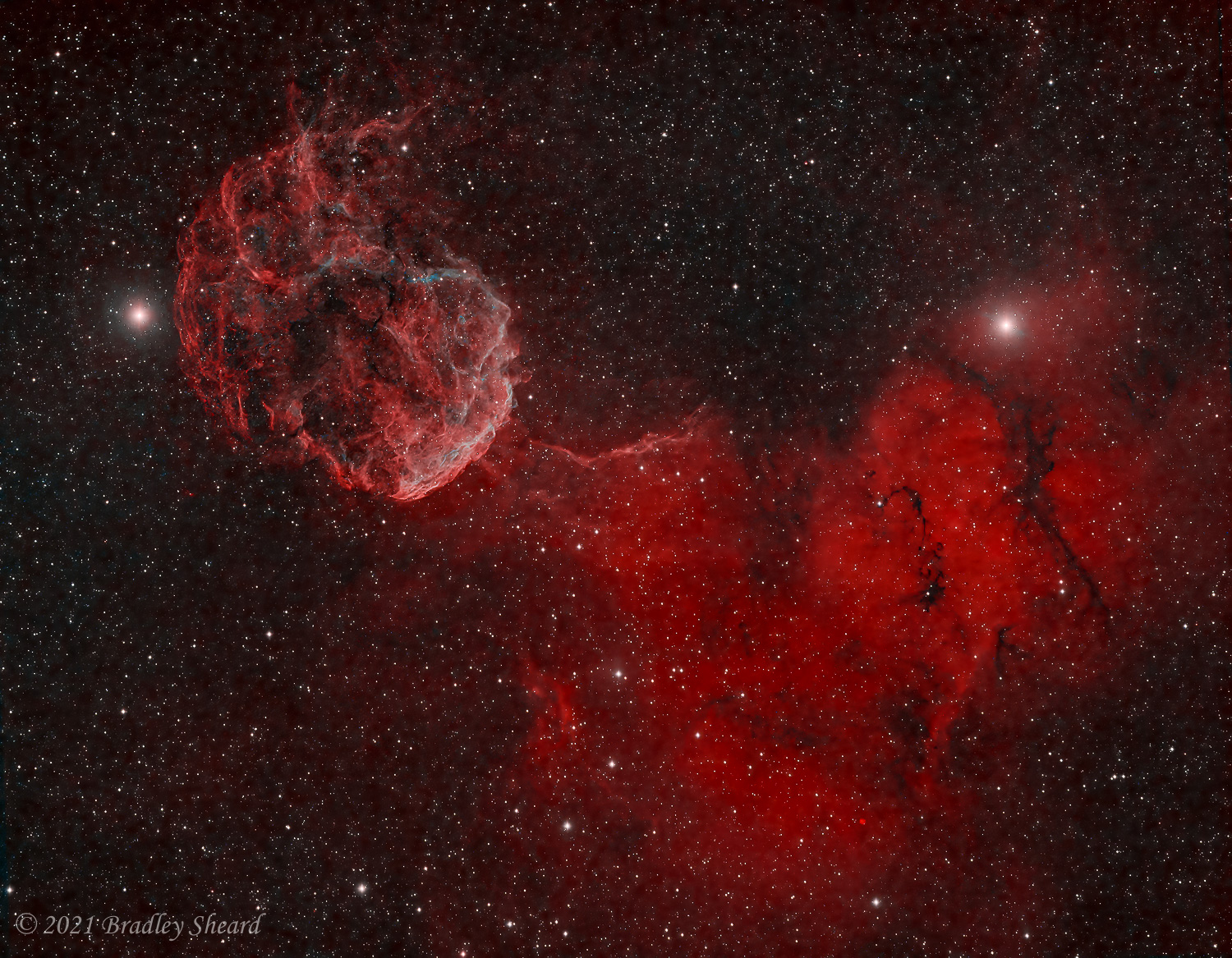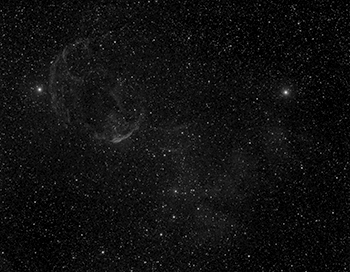"Jellyfish Nebula" (IC 443 / Sh 2-248) and Sharpless 2-249 | |||
| « Previous | Back to Astrophotography Gallery | Next » | |
| Back to Supernova Gallery | |||
The 'Jellyfish Nebula' (IC 443 / Sh 2-248), in the upper left of the image below, is "a classic example of an evolved supernova remnant (SNR)," (Reference 2)--ie. the remains of a star that exploded at the end of its life. Located in the constellation Gemini, the two brightest stars in this scene (Tejat Posterior and Tejat Prior, or Propus) make up the "left foot" of the twin Castor; both are red giants. Although not apparent visually, according to Reference 2 "IC 443 consists of three interconnected roughly spherical subshells which have substantially different radii and centroids." To the lower right of IC 443 is a large emission nebula (Sh 2-249) and molecular cloud that is believed to be associated with the supernova remnant (Reference 3). Distance estimates vary to these structures, with Reference 3 giving an estimate of 1729 pc (5636 light years). Recently a pulsar (neutron star) was discovered within IC443, but because it does not lie at the geometric center of the remnant, it was unclear if this was the remains of the supernova that created the SNR shells. The recent discovery of an associated jet-like structure (Reference 4), however, has led to the conclusion that this is indeed the remains of the supernova that created the nebula, but that the neutron star is traveling away from the original location of the explosion. The neutron star is designated CXOU J061705.3+222127 (indicated by the small white circle in the roll-over annotated image below), and is the remnant of a core-collapse supernova that formed the Jellyfish Nebula. The supernova's age estimate is ~ 4,000 years. | |||
 | |||
 | |||
| Optics: | Stellarvue SVQ-100 refractor | ||
| Camera: | SX-46 CCD camera | ||
| Exposure info: | 23 hours total exposure / 20 min subs | ||
| Filters used: | Astrodon narrowband filters: Ha (5nm), SII (5 nm), OIII (3 nm) | ||
| Date: | March 2021 | ||
| Processing: | Pixinsight-->Photoshop-->Lightroom | ||
The image above was taken through narrowband filters, with a monochrome camera and assembled into an RGB image using two different color palettes: a modified Hubble palette (top), and a version using only the H-alpha and SII channels (bottom). Below are the individual filter channels. The H-alpha channel, as expected, is the brightest of the three filters; for this particular image, however, the SII channel is surprisingly strong as well. | ||
 |
 |
 |
| H-alpha image | SII image | OIII image |
 | The constellation Gemini the twins is located to the north of the Milky Way's winter belt--in fact one could imagine that the famous twins are wading, with their feet immersed in that Milky band of light. The two twins that make up the constellation, Castor and Pollux, are taken from Greek mythology and are the children of Zeus and Leda. Zeus was the king of the Olympic gods and was guilty of numerous adulterous affairs and had many offspring, while Leda was a queen of Sparta, and the mother of Helen of Trojan War fame. The two brightest stars in the constellation, appropriately named Castor and Pollux, form the twin's heads. The view at left shows the basic form of the constellation, with the approximate outline of the image above shown as a dotted rectangle. |
| Plot Credit: The Sky Live | |
| The Sky Live |
REFERENCES
1. van den Bergh, Marscher and Terzian, "An Optical Atlas of Glactic Supernova Remnants." The Astrophysical Journal Supplement Series, No 227, 26:19-36, 1973.
2. Braun and Strom, "The Structure and Dynamics of Evolved Supernova Remnants. The IC 443 Complex." Astronomy and Astrophysics; 164, 193-207 (1986).
3. Yu et al, "Three Dimensional Dust Mapping of 12 Supernovae Remnants in the Galactic Anticentre." Monthly Notices of the Royal Astronomical Society, v. 488, Issue 3, p. 3129-3142 (2019).
4. Greco et al, "Discovery of a Jet-like Structure with Overionized Plasma in the SNR IC443" Astronomy and Astrophysics, 17 April 2018.